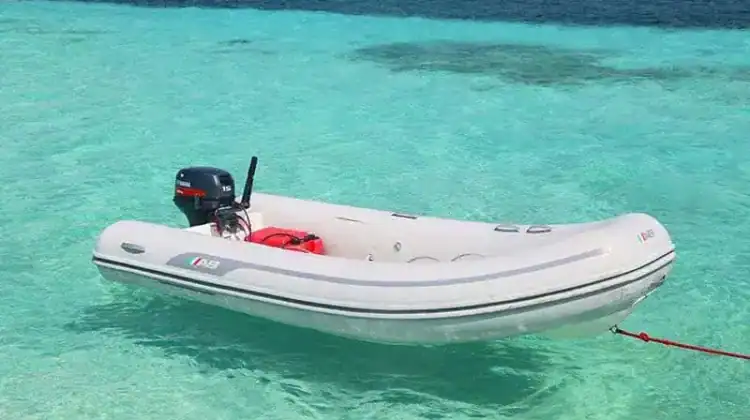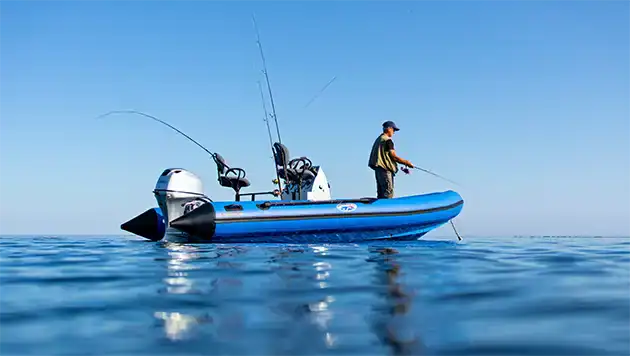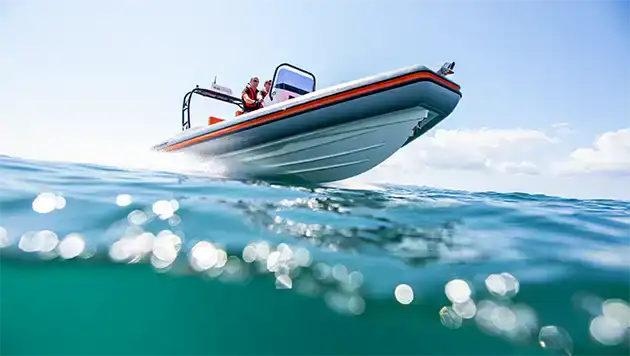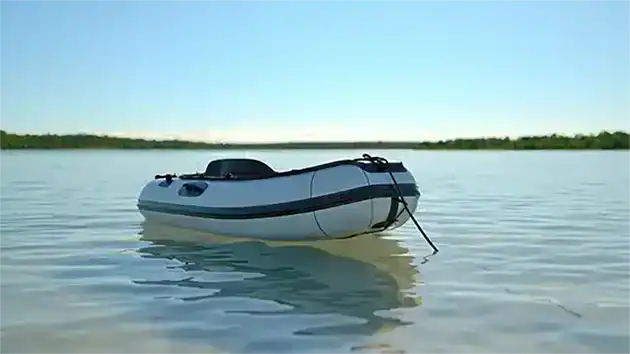
Thank you for reading our post, please rate this article at the end.
Reading Time: 9 minutesLast Updated on October 21, 2025 by Paul Clayton
Table of Contents
How To Choose The Best Inflatable Boat
Key Takeaways
-
- Growing Popularity and History: Inflatable boats are increasingly popular for recreation and transportation because they are lightweight, versatile, affordable, and convenient. Primitive versions made from animal skins existed in ancient times.
- Selection is Based on Application: The intended use is the primary factor in choosing a boat type:
- Recreation: Inflatable Rafts (best for small water bodies).
- Fishing: Inflatable Pontoon Boats (catamarans with high weight capacity).
- Versatility: Inflatable Kayaks (good for lake boating, fishing, and longer river journeys).
- Sporting: Inflatable Dinghies (robust, lightweight, can use an outboard motor).
- Patrolling/Surveillance: Rigid Inflatable Boats (RIBs) (rigid hull, unsinkable, for seas).
- Design and Keel Impact Performance:
- With Keels (a longitudinal backbone) offer enhanced stability, smoother movement, and adaptability to all water types, including oceans (but are costlier).
- Without Keels are portable, compact, and easier to set up for flat, small water bodies and shorter trips (but lack robustness and speed).
- Hull Type Determines Speed and Stability: The hull is the watertight body and a key determinant of efficiency.
- Flat Hull: Less stable, medium speed, suited for small water bodies and short distances.
- V Hull: Faster, more stable, with inflatable keels (suited for fishing, diving, and wildlife).
- Deep V Hull: Most stable, best performance in rough or calm water, highest speed, mostly on RIBs (costliest).
- Fabric Choices Affect Durability and Cost:
- Hypalon: Best durability, highly resistant to abrasion, UV rays, temperature, and chemicals (but is costly and prone to getting dirty).
- Polyvinyl Chloride (PVC): More affordable, lightweight, and easy to repair (but has a shorter lifespan, is not resistant to UV rays or chemicals, and can deteriorate quickly).
- Floor Type Affects Performance and Stability:
- Roll-up Floor: Least expensive, aluminum or wood (less stable, for shorter, slower trips).
- Hard Flooring: Sturdy, enhances hull shape for better speed and performance in bigger water bodies.
- Air Floor: Lightweight, good speed/stability for shorter water bodies (prone to punctures).
- Self-bailing Floors: Have holes to drain water, ideal for white-water rafting.
Frequently Asked Questions
What are the main advantages of choosing an inflatable boat?
Inflatable boats are lightweight, versatile, affordable, convenient, and easy to transport and store compared to traditional rigid boats.
What should I consider first when buying an inflatable boat?
The most important factor is the intended use or application (e.g., recreation, fishing, long journeys, or rough water). This will determine the best boat type, hull, and material for your needs.
Which type of inflatable boat is best for casual recreation on small lakes?
An Inflatable Raft is generally the best and most popular choice for recreation and transportation on small, calmer water bodies.
What kind of inflatable boat is recommended for fishing?
An Inflatable Pontoon Boat (catamaran) is ideal for fishing due to its stable design, high weight capacity, and enhanced viewing position.
If I need a boat for both fishing and longer river trips, what should I get?
An Inflatable Kayak is the most versatile option. It is suitable for lake boating, fishing, and longer river journeys due to its user-friendly, lightweight, and durable nature.
What is a Rigid Inflatable Boat (RIB) and what is it used for?
A RIB has a rigid hull combined with an inflatable collar. It is unsinkable and suitable for rough seas. RIBs are typically used for patrolling, surveillance, and demanding conditions.
Does an inflatable boat need a keel?
A keel enhances performance, offering better stability and smoother movement. Boats with keels are better for varied conditions, including the sea, while boats without keels are easier to set up, more portable, and ideal for flat, calm water.
Which hull type offers the best performance and stability?
The Deep V Hull (mostly found on RIBs) offers the best stability and performance, especially in waves, and can handle high speeds easily. The V Hull is a good intermediate option, being faster and more stable than the Flat Hull.
Which fabric material is more durable: Hypalon or PVC?
Hypalon is the most durable, offering superior resistance to abrasion, UV rays, temperature variations, and chemicals. However, it is also the most expensive. PVC is more affordable but has a shorter lifespan.
What is the best floor type for handling rough water conditions?
Hard Flooring is best for bigger water bodies and rough conditions, as it provides a sturdy platform and enhanced hull shape. Self-bailing Floors are essential for white-water rafting to drain incoming water.
Are air-filled floors a good option?
Air Floors are lightweight and offer good speed and stability for shorter trips on calm water. However, they are generally more prone to punctures than hard floors.
How to Choose the Best Inflatable Boat?
The growing interest in aquatic amusement and entertaining activities has witnessed a surge in demand for inflatable boats. These boats are commonly used these days either as lifeboats or for recreation.
Even though modern-day inflatable boats are made from materials like plastic or synthetic rubber, similar vessels made from animal skins existed in ancient times. Though these were smaller, prehistoric carvings prove that these boats were inflated with air blown by the mouth and were mainly used for transportation on small water bodies.
At present, inflatable boats are lightweight, versatile, affordable, and convenient to use. They serve multiple purposes, and users buy them based on various factors.
Based on Use/Application
These are the five different types of inflatable boats:
1. Recreation Purpose: Inflatable Raft
The most popular inflatable boat is a lifeboat used for recreation and transportation. Typically, these are used only on small water bodies because their layouts and designs are not favorable for strong sea currents. Bigger rafts have enhanced features, including safety valves, fishing rod holders, inflatable keels, grab ropes, different air chambers, and more.
Depending on the quality and make of the rafts, the prices differ.
2. Fishing Purpose: Inflatable Pontoon Boat
This type of boat serves the purpose of fishing and is commonly known as a catamaran. Due to the nature of the work, the boat has a higher weight capacity.
The design consists of two sides made from flexible air-filled tubes with a metallic frame or a curved air bladder connected to the sides. The design makes for easy maneuverability, while the tubes enable smooth movement on the water.
In between, there’s a seat in the center, either an inflatable or a metallic frame boat seat, offering an enhanced view around.
The larger versions can accommodate about 2-4 people simultaneously, but these need to be towed by trailers.
3. All-Purpose Boats: Inflatable Kayak
The inflatable kayak is quite a common choice as it is versatile and serves multiple functions. Inflatable kayaks are usually the first choice for lake boating, fishing, and longer journeys on rivers.
Irrespective of the kayak type, these are user-friendly, lightweight, long-lasting, and safe.
4. Sporting Activities: Inflatable Dinghy
Inflatable dinghies are robust, lightweight, and usually last long even under tough & rugged conditions. Available in varied types, the flooring material is the differentiating factor.
Notably, the quality is high-class and sometimes gets used on the sea. Operable via a mounted outboard motor, these boats can accommodate a single person
5. Patrolling & Surveillance Purpose: Rigid Inflatable Boat (RIB)
The RIBs have a rigid hull that blends a traditional boat with an inflatable one. Due to this, the boats are unfoldable and cannot be dismantled. Also, they can work on the seas and are usually unsinkable.
Due to the nature of the work, you can easily operate these formidable vessels.
Based on Design
The functional aspect of the boat, along with its speed, is determined by its design. Generally, when considering the boat’s design, there are two choices: with and without a keel. The backbone of the boat, running longitudinally along the center of the boat’s bottom, offers resistance and stability to the vessel.
1. With Keels
A keel in an inflatable boat enhances its performance on the water, allowing it to move smoothly. Keels also make the boats adaptable to all kinds of water, including oceans and seas. An inflatable boat with a keel is usually costlier than its counterpart. Typical examples are inflatable tenders and Rigid Inflatable Boats.
2. Without Keels
While boats without a keel may lack robustness, they can be set up or inflated and deflated easily and are portable and compact. They also cost less and are more user-friendly, especially when entering the water from land. Thus, these are great carriers on small water bodies where the water is flat and suitable for shorter trips.
There are multiple drawbacks, though; for example, the vessel’s speed and scope are limited. In addition, these boats are usually tricky to board.
Based on the Hull
The hull is the watertight boat body that protects the occupants and cargo onboard from flooding, weather, and damage. It is an important consideration because it influences the boat’s efficiency. Multiple types of hulls serve varied purposes and functionalities.
1. Flat Hull
Flat hulls, made from either CSM or PVC, are without a keel. That is why they are unstable, complex to maneuver, move at medium speeds, and perform poorly when moving through planes. Therefore, they suit smaller water bodies, shorter distances, and lower speeds.
2. V Hull
Made of CSM or PVC, these inflatable hulls come with inflatable keels. The floor is either made from hardwood or high-pressure air that empowers the keel to move smoothly through the water.
V hulls are faster, more stable, and can move swiftly on planes compared to flat hulls. They assist in fishing and diving activities and wildlife adventures. However, V hulls are costlier than flat hulls.
3. Deep V Hull
The best hull type of all three, these are mostly found on RIBs. These are highly stable and perform brilliantly on calm water or waves. High speed is not a challenge, and maneuvering is equally easy. For these reasons, the deep V hulls are the costliest of the lot.
The only disadvantage is that they can get unstable during winds, though they are made for rough waters.
Based on the Fabric Type
1. Hypalon
One of the best materials, Hypalon, is a synthetic rubber that is resistant to wear, tear, and abrasion. It is used as a polyester coating and is resistant to temperature variations and harmful UV rays. In addition, the lightweight material is portable and foldable, and does not deteriorate or become brittle when kept for long hours in the sun.
The durable material is resistant to chemicals and can be repairable with a patch. Since Hypalon is costly, the boat is expensive. The material fades with time, and the porous finish makes it prone to getting dirty quickly.
2. Polyvinyl Chloride (PVC)
The best part about PVC is that it is cheaper than Hypalon. Thus, inflatable boats are affordable. The other distinct advantage of PVC is that it is lightweight. Thus, the boat is portable and easy to repair. Available in a plethora of colors, the seams of the material are bonded or glued thermally.
On the downside, PVC materials have a short life span. Since they are not resistant to wear-and-tear or external conditions like UV rays, temperature variations, and chemicals, boats are prone to deteriorating quickly.
Based on Floor Type
The floor type determines the boat’s performance, like mobility, compact design, and storage.
1. Roll-up Floor
Inflatable boats with roll-up floors are entry-level vessels, as they are the least expensive compared to boats with floors of other materials. These floors are aluminum-made or wooden; hence, they are not stable and have shorter lives.
Even though the boats are portable, compact, and easy to set up and use, they are best suited for shorter trips at a slower speed. Roll-up floors are mostly found on boats without keels and are available in multiple dimensions and qualities.
2. Hard Flooring
Hard-floored boats have an enhanced hull shape that influences the vessel’s speed and performance. The sturdy flooring material increases the cost of the boat, but it is quite popular as they are best suited for bigger water bodies.
The floors facilitate smoother rides even in harsh conditions. Inflating and deflating boats with hard floors is simple.
3. Air Floor
As the name suggests, these floors are filled with air, helping reduce the boat’s weight. They are also suitable for shorter water bodies, as they cannot handle rough water.
The air-filled floors offer incredible speed, stability, and improved performance, but are prone to punctures. Nevertheless, boating enthusiasts favour these boats due to their versatile nature.
4. Self-bailing Floors
Self-bailing floors have holes on their sides so that if water enters the boat, it can flow out through the holes. Typically, boats come with non-bailing floors, in which case, the water has to be collected manually and then thrown out.
Boats with self-bailing floors are ideal for white-water river rafting, where water is bound to enter the vessel.
Besides the features mentioned above, it is imperative to know about the water body and the surroundings where the boat will be used. Furthermore, whatever the activity type, it is pertinent to carry the necessary tools during rides and ensure timely maintenance. Also, it would be best to store boats in an appropriate place to ensure longevity and negligible wear and tear.
Final Thoughts
Inflatable boats serve multiple purposes. From industrial to recreational, they are immense support because they can be conveniently used and are economical.
Choosing the best inflatable boat requires a comprehensive review of several interlocking factors, all driven by the boat’s primary intended use and the water conditions where it will operate.
Key considerations include the boat type (raft, pontoon, kayak, dinghy, or RIB), the presence of a keel for stability, the hull type for speed and maneuverability (Flat, V, or Deep V), and the fabric material (Hypalon for durability, PVC for affordability).
The floor type (roll-up, hard, air, or self-bailing) further dictates performance, stability, and portability.
Regardless of the selection, proper maintenance and storage are essential to maximizing the inflatable vessel‘s longevity and minimizing wear and tear.






